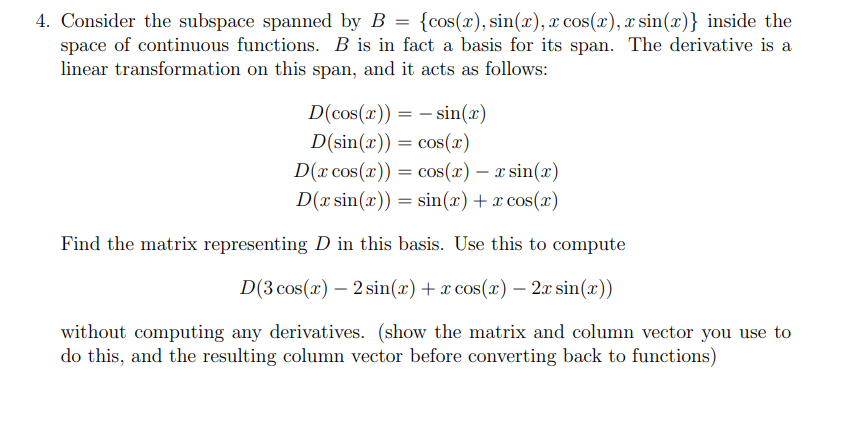Consider the subspace spanned by B = {cos(x), sin(x), x cos(x), x sin(x)} inside the space of continuous functions. B is in fact a basis for its span. The derivative is a linear transformation on this span, and it acts as follows: D(cos(x)) = – sin(x) D(sin(x)) = cos(x) D(x cos(x)) = cos(x) – x sin(x) D(r sin(x)) = sin(x) + x cos(x) Find the matrix representing D in this basis. Use this to compute D(3 cos(x) – 2 sin(x) + x cos(x) – 2x sin(x)) without computing any derivatives. (show the matrix and column vector you use to do this, and the resulting column vector before converting back to functions)
Consider the subspace spanned by B = {cos(x), sin(x), x cos(x), x sin(x)} inside the space of continuous functions. B is in fact a basis for its span. The derivative is a linear transformation on this span, and it acts as follows: D(cos(x)) = – sin(x) D(sin(x)) = cos(x) D(x cos(x)) = cos(x) – x sin(x) D(r sin(x)) = sin(x) + x cos(x) Find the matrix representing D in this basis. Use this to compute D(3 cos(x) – 2 sin(x) + x cos(x) – 2x sin(x)) without computing any derivatives. (show the matrix and column vector you use to do this, and the resulting column vector before converting back to functions)
Linear Algebra: A Modern Introduction
4th Edition
ISBN:9781285463247
Author:David Poole
Publisher:David Poole
Chapter6: Vector Spaces
Section6.4: Linear Transformations
Problem 34EQ
Related questions
Topic Video
Question

Transcribed Image Text:4. Consider the subspace spanned by B = {cos(x), sin(x), x cos(x), x sin(x)} inside the
space of continuous functions. B is in fact a basis for its span. The derivative is a
linear transformation on this span, and it acts as follows:
D(cos(x)) = – sin(x)
D(sin(x)) = cos(x)
D(x cos(x)) = cos(x) – x sin(x)
D(x sin(x)) = sin(x) + x cos(x)
Find the matrix representing D in this basis. Use this to compute
D(3 cos(x) – 2 sin(x)+x cos(x) – 2.x sin(x))
without computing any derivatives. (show the matrix and column vector you use to
do this, and the resulting column vector before converting back to functions)
Expert Solution
This question has been solved!
Explore an expertly crafted, step-by-step solution for a thorough understanding of key concepts.
Step by step
Solved in 2 steps with 2 images

Knowledge Booster
Learn more about
Need a deep-dive on the concept behind this application? Look no further. Learn more about this topic, algebra and related others by exploring similar questions and additional content below.Recommended textbooks for you

Linear Algebra: A Modern Introduction
Algebra
ISBN:
9781285463247
Author:
David Poole
Publisher:
Cengage Learning

Elementary Linear Algebra (MindTap Course List)
Algebra
ISBN:
9781305658004
Author:
Ron Larson
Publisher:
Cengage Learning

Linear Algebra: A Modern Introduction
Algebra
ISBN:
9781285463247
Author:
David Poole
Publisher:
Cengage Learning

Elementary Linear Algebra (MindTap Course List)
Algebra
ISBN:
9781305658004
Author:
Ron Larson
Publisher:
Cengage Learning